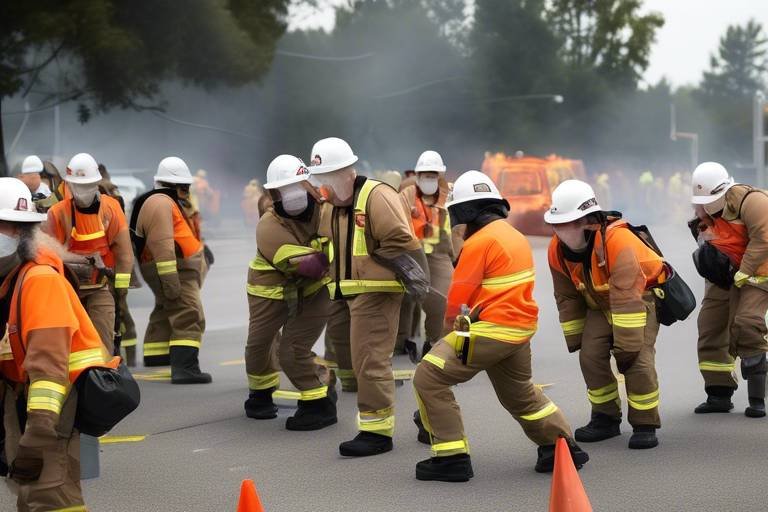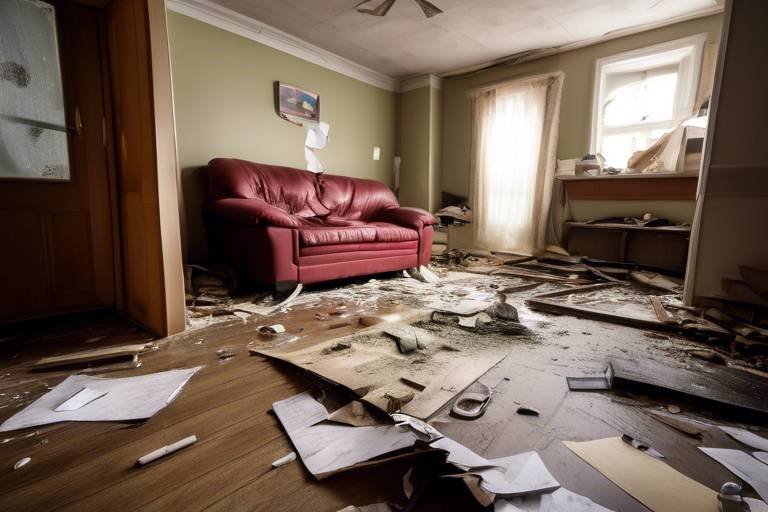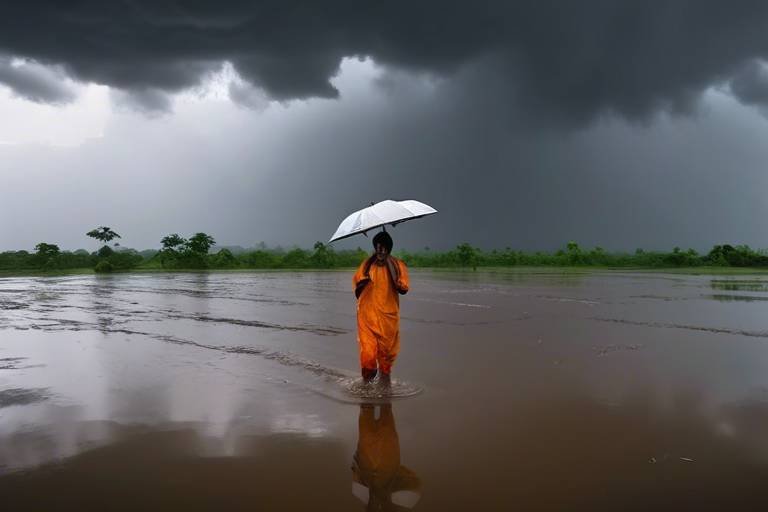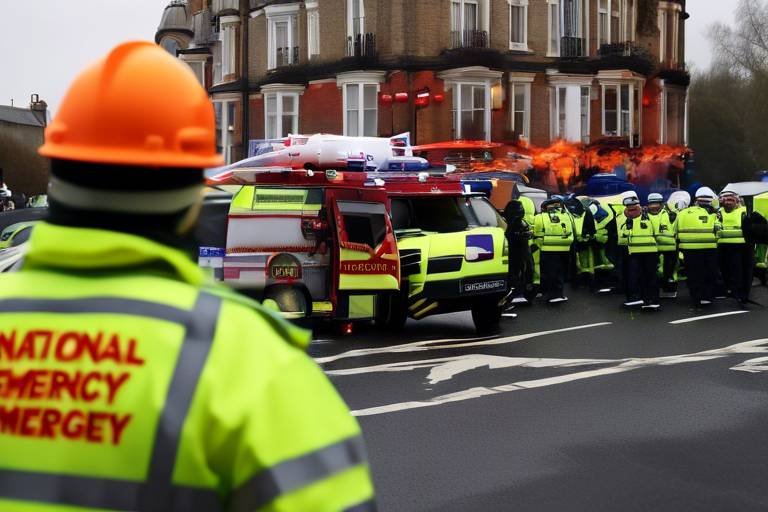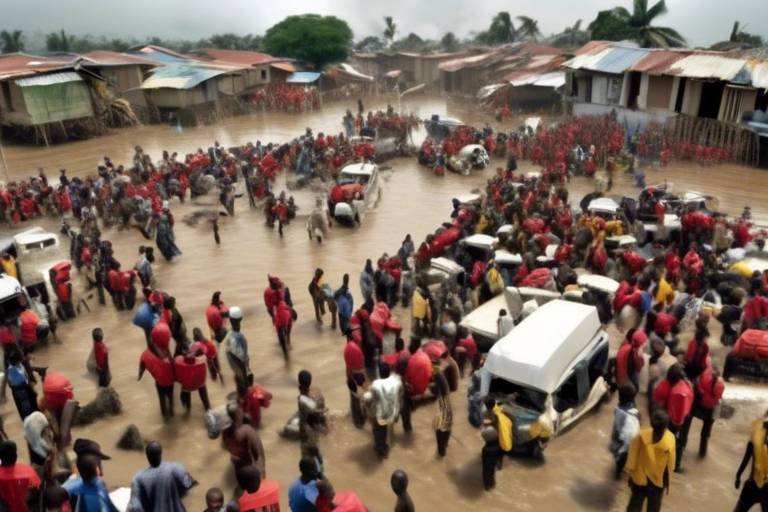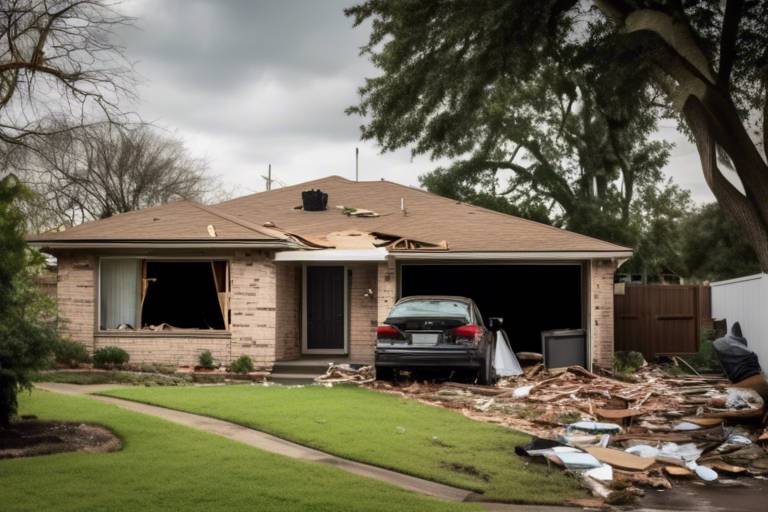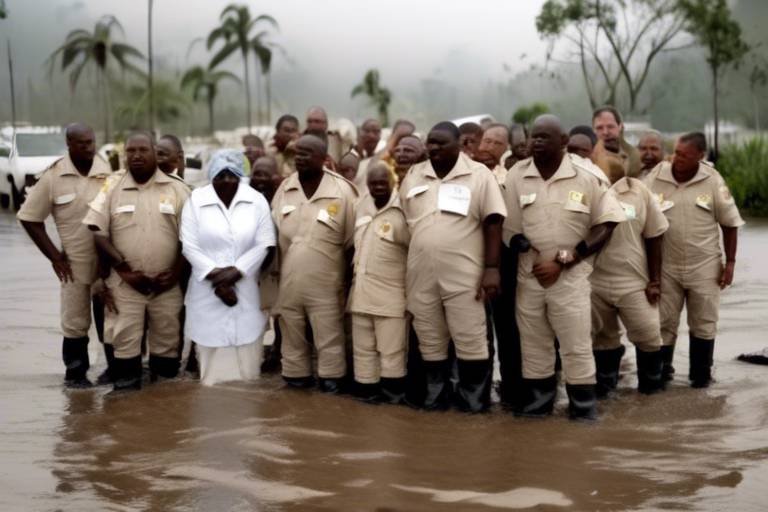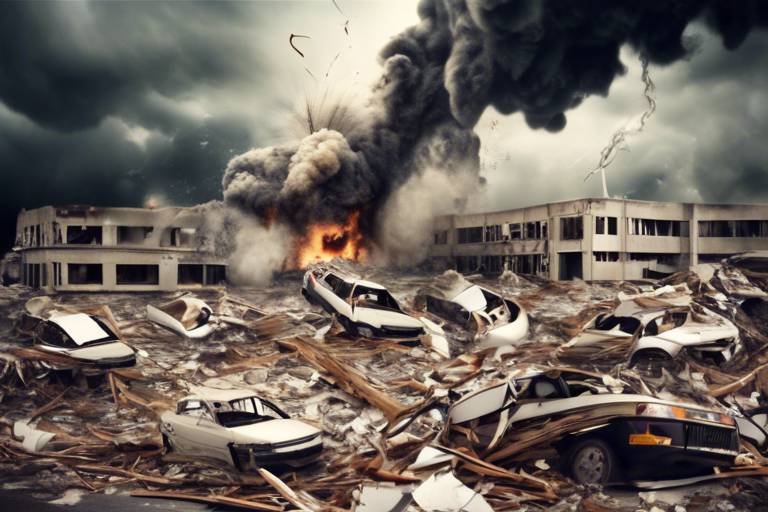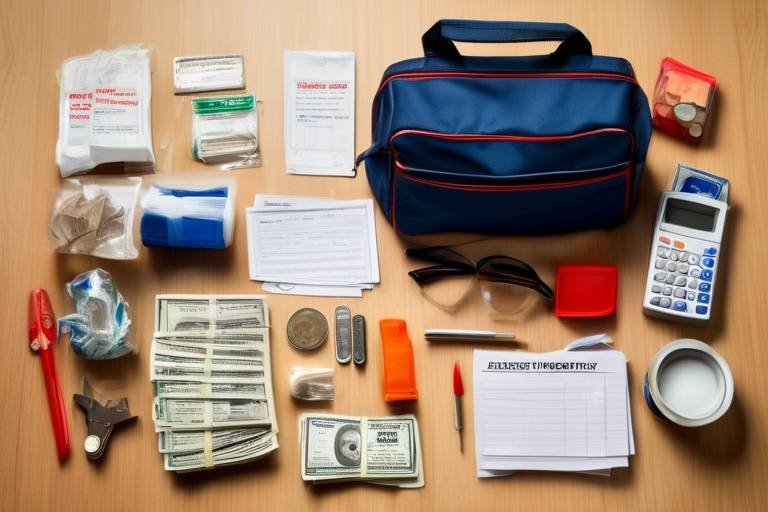Organizing Community Disaster Drills - What You Need to Know
In today's unpredictable world, the importance of being prepared for disasters cannot be overstated. Whether it's a natural calamity like a hurricane or an unexpected event such as a chemical spill, communities must be ready to respond effectively. Organizing community disaster drills is a proactive way to ensure that individuals and organizations know how to react in emergencies. These drills are not just about practicing; they are about building a culture of safety, enhancing communication, and fostering resilience among residents. In this article, we will delve into the essential insights for effectively organizing disaster drills, covering everything from planning to execution and evaluation.
Disaster drills serve as a vital training ground for communities, enabling residents to familiarize themselves with emergency procedures and protocols. By participating in these drills, individuals gain an understanding of their specific roles and responsibilities during a crisis, which significantly improves response times. Imagine a fire alarm going off in a crowded building; if everyone knows their exit routes and assembly points, chaos can be avoided. Moreover, these drills foster a culture of safety, where preparedness becomes second nature. When a community regularly engages in disaster drills, it cultivates an environment where residents feel empowered and ready to take action when it matters most.
Effective planning is the backbone of successful disaster drills. To ensure that your drill is impactful, follow these essential steps:
- Set Clear Objectives: Define what you want to achieve with the drill, whether it's improving evacuation times or enhancing communication among responders.
- Assemble a Planning Committee: Gather a team of diverse stakeholders, including local government officials, emergency services, and community leaders, to collaborate on the planning process.
- Select Appropriate Scenarios: Choose scenarios that reflect the specific hazards your community may face, ensuring that the drill is relevant and engaging.
Recognizing the specific hazards that could impact your community is essential for tailoring a disaster drill. This helps ensure that the drill is relevant and addresses the most likely emergency situations. For instance, if you live in an area prone to earthquakes, incorporating earthquake response into your drill is crucial. On the other hand, communities near industrial areas may need to focus on chemical spills or explosions. Understanding these risks allows you to create a drill that resonates with participants and prepares them for real-life scenarios.
A thorough risk assessment provides insight into potential threats and vulnerabilities. This process involves evaluating community resources, infrastructure, and population needs to inform drill planning. By assessing factors such as population density, building safety, and available emergency services, you can identify gaps in preparedness and address them through targeted training. This proactive approach not only enhances the effectiveness of the drill but also boosts overall community resilience.
Involving local organizations, government agencies, and community members in the planning process fosters collaboration and ensures that diverse perspectives and resources are incorporated into the drill. By engaging stakeholders, you create a sense of ownership and commitment to the drill's success. Moreover, it opens the door for resource sharing, whether it's funding, facilities, or expertise, which can significantly enhance the drill's quality and impact.
Creating a realistic scenario for the drill is crucial for effective training. Scenarios should challenge participants and reflect actual emergency situations faced by the community. For example, if your community has a history of flooding, simulate a flood response scenario that requires participants to evacuate quickly and safely. The more realistic the scenario, the better prepared participants will be when faced with a true emergency.
The execution phase is where planning comes to life. It's essential to ensure that all logistics are in place for a smooth and effective drill. This includes clear communication, coordination among various agencies, and prioritizing participant safety throughout the event. Remember, the goal is not just to practice but to create a safe environment where individuals can learn and grow from their experiences.
Proper training of facilitators and participants is essential for a successful drill. This includes providing clear instructions, clarifying roles, and ensuring everyone understands the objectives and procedures before the drill begins. Think of facilitators as the coaches of a sports team; they need to prepare their players for the game. By equipping them with the right tools and knowledge, you set the stage for a productive and enlightening experience.
Effective communication during a disaster drill is critical for coordination and safety. Various communication methods and technologies can enhance information flow among participants. Consider using two-way radios, mobile apps, or even social media platforms to keep everyone informed. The key is to ensure that communication is clear, concise, and accessible to all participants, enabling them to respond swiftly and efficiently.
Post-drill evaluation is key to understanding strengths and areas for improvement. It’s like reviewing game footage after a match; you need to analyze what worked and what didn’t. This process involves gathering feedback from participants, assessing performance metrics, and applying lessons learned to future drills. By continually refining your approach, you can enhance community preparedness and ensure that everyone is ready for whatever challenges may arise.
Gathering feedback from participants helps identify successes and challenges encountered during the drill. This information is vital for refining future drills and enhancing community preparedness. Consider conducting surveys or holding debriefing sessions to discuss experiences and gather insights. The more input you receive, the better equipped you’ll be to make necessary adjustments.
Establishing performance metrics allows organizers to objectively evaluate the drill's effectiveness. This includes assessing response times, communication efficiency, and overall participant engagement during the exercise. By analyzing these metrics, you can pinpoint areas that need improvement and celebrate successes, motivating participants for future drills.
Q: How often should we conduct disaster drills?
A: It's recommended to conduct disaster drills at least once a year, but more frequent drills can enhance preparedness, especially if your community faces specific risks.
Q: Who should participate in the drills?
A: Everyone in the community should be encouraged to participate, including residents, local businesses, and emergency services. The more comprehensive the participation, the better the community will be prepared.
Q: What if someone is unable to participate in the drill?
A: It's important to provide alternative training methods, such as online resources or informational workshops, to ensure that everyone can access the necessary information and skills.

Understanding the Importance of Disaster Drills
Disaster drills are not just a checkbox on a community safety list; they are a vital component of emergency preparedness that can mean the difference between chaos and calm during a real crisis. Imagine a fire breaking out in a crowded building—how would people react? Would they know where to go? Would they remember the exit routes? This is where the significance of disaster drills shines through. By simulating emergencies, communities can foster a sense of readiness and ensure that individuals understand their roles when the unexpected happens.
One of the primary benefits of conducting disaster drills is the opportunity for individuals to practice their responses in a controlled environment. This practice enhances their ability to react swiftly and effectively when faced with actual emergencies. Furthermore, these drills serve to improve response times, as participants become familiar with protocols and procedures, allowing them to act decisively when every second counts.
Moreover, disaster drills cultivate a culture of safety and preparedness within the community. When residents actively participate in these exercises, they become more aware of potential hazards and the importance of emergency planning. This awareness can lead to increased community engagement, where individuals are more likely to share information, resources, and strategies to enhance overall safety.
To illustrate the importance of disaster drills, consider the following key points:
- Enhanced Knowledge: Participants gain crucial insights into emergency procedures, which can save lives.
- Teamwork and Collaboration: Drills encourage individuals to work together, fostering a spirit of cooperation that is essential during crises.
- Identifying Weaknesses: Through practice, communities can pinpoint areas that need improvement, whether it's communication gaps or resource shortages.
In summary, disaster drills are indispensable for preparing communities to face emergencies. They transform theoretical knowledge into practical skills, allowing individuals to navigate crises with confidence. By prioritizing these exercises, communities not only enhance their own safety but also contribute to a more resilient society, ready to tackle whatever challenges may arise.

Key Steps in Planning a Disaster Drill
Planning a successful disaster drill requires careful thought and organization. It’s not just about gathering people and simulating an emergency; it’s about crafting an experience that truly prepares your community. The first step is to set clear objectives. What do you want participants to learn? Is it improving evacuation times, enhancing communication, or perhaps understanding their roles during a crisis? Defining these goals will guide every decision you make moving forward.
Next, it's crucial to assemble a planning committee. This diverse group should include local leaders, emergency responders, and community members. Why? Because having a mix of perspectives ensures that the drill is comprehensive and addresses the unique needs of your community. Each member can bring valuable insights that will shape the drill into a more effective training exercise.
Now, let’s talk about selecting appropriate scenarios. Consider the specific hazards your community faces. Is it prone to floods, earthquakes, or perhaps wildfires? Tailoring the drill to reflect these risks not only makes it relevant but also heightens the urgency and realism of the training. You might even want to create a scenario that combines multiple hazards to test how well participants can adapt under pressure.
To help in this process, conducting a risk assessment is essential. This involves evaluating local resources, infrastructure, and the needs of your population. By identifying potential threats and vulnerabilities, you can ensure that the drill is designed to address the most pressing concerns. For example, if a significant portion of your community relies on a single access road, it would be wise to include scenarios that simulate this route being blocked during an emergency.
Another important step is engaging community stakeholders. This means reaching out to local organizations, government agencies, and even schools. Their involvement not only fosters collaboration but also enhances resource sharing, which can be invaluable during the drill. Imagine having local businesses provide supplies or schools allow their facilities to be used as staging areas. The more you involve the community, the more robust your drill will be.
Finally, as you develop your drill, consider how to make it as realistic as possible. This means thinking about the logistics—how will you communicate during the drill? What roles will each participant play? By simulating real-world conditions, you can better prepare your community for actual emergencies. Remember, the goal is to create a learning experience that is both challenging and enlightening.
- What is the best time to conduct a disaster drill? It's best to schedule drills during times when most community members can participate, such as weekends or evenings.
- How often should drills be conducted? Regular drills, ideally semi-annually or annually, help keep preparedness fresh in everyone’s mind.
- What should I do if participants are unprepared? Use this as a learning opportunity! Gather feedback and adjust future drills to address these gaps.

Identifying Potential Hazards
When it comes to organizing community disaster drills, one of the most critical steps is . Think of it as laying the foundation for a sturdy house; without a solid base, everything else can crumble. In your community, various hazards could arise, and recognizing them is essential to tailor your drill effectively. This isn’t just about ticking boxes—it's about ensuring that the drill resonates with real-life situations that your community might face.
Start by considering the geographical location of your community. Are you near a fault line, making earthquakes a real threat? Or perhaps you're situated in a flood-prone area? By understanding your surroundings, you can pinpoint the most pressing risks. For instance, if your community is susceptible to severe weather, such as hurricanes or tornadoes, it’s crucial to include those scenarios in your drills.
Moreover, you should also take into account the demographics of your community. Different age groups and populations have unique vulnerabilities. For example, elderly residents might require specific assistance during evacuations, while schools may need to focus on child safety protocols. Engaging with community members can provide invaluable insights into their concerns and experiences. You might find that certain hazards are more prevalent in their minds, which can guide your planning process.
To assist with identifying hazards, consider conducting a community survey. This can be a simple questionnaire that asks residents about their perceptions of risks. Here’s a quick overview of what you might include in your survey:
| Question | Purpose |
|---|---|
| What types of emergencies are you most concerned about? | Identifies key hazards in the minds of residents. |
| Have you experienced any emergencies in the past? | Gathers historical data on past incidents. |
| What resources do you think are lacking in our community? | Highlights areas for improvement in preparedness. |
Once you gather this data, you can create a comprehensive list of potential hazards, which may include:
- Natural disasters (earthquakes, floods, hurricanes)
- Technological hazards (chemical spills, power outages)
- Human-made hazards (terrorism, civil unrest)
By taking the time to identify these hazards, you’re not just preparing for a drill; you’re actively working to create a safer community. Remember, the goal is to ensure that everyone knows their role and feels confident when faced with an actual emergency. With a tailored approach to disaster drills, you can empower your community to respond effectively and cohesively when it matters most.

Conducting a Risk Assessment
Conducting a risk assessment is a fundamental step in preparing your community for potential disasters. It’s like putting on your detective hat and investigating what could go wrong in your neighborhood. By identifying vulnerabilities and potential threats, you can tailor your disaster drills to address the specific needs of your community. This process involves a systematic evaluation of various factors that could impact safety and response during emergencies.
Start by examining the community resources available, such as emergency services, hospitals, and shelters. Understanding what resources are at your disposal allows you to leverage them effectively during a drill. Next, consider the infrastructure of your community. Are there any old buildings or bridges that might pose a risk during an earthquake? Are emergency exits clearly marked and accessible? These questions help to paint a clearer picture of your community's readiness.
Additionally, it’s essential to take into account the population needs. Different demographics may have unique requirements during emergencies. For instance, the elderly or individuals with disabilities may need special assistance. By recognizing these factors, you can create a more inclusive and effective disaster drill. Here’s a quick overview of the key components to consider during your risk assessment:
- Identify potential hazards: Natural disasters, technological threats, and human-made incidents.
- Evaluate community resources: List available emergency services and facilities.
- Assess infrastructure: Check the condition and accessibility of buildings and roads.
- Consider population demographics: Understand the needs of different groups within your community.
After gathering all this information, it’s time to analyze it. You can create a risk matrix to prioritize hazards based on their likelihood and potential impact. This visual tool helps in making informed decisions about which scenarios to focus on during your drills. For example, if flooding is a high-risk scenario for your community, you would want to ensure that your disaster drill includes flood response protocols.
In summary, conducting a risk assessment is not just a checkbox on your planning list; it’s a crucial step that lays the groundwork for effective disaster preparedness. By understanding the unique challenges your community faces, you can design drills that not only educate but also empower residents to respond confidently in the face of emergencies. Remember, the goal is to create a culture of preparedness and safety, where everyone knows their role and feels ready to act when it matters most.
1. What is a risk assessment?
A risk assessment is a systematic process for identifying and evaluating potential hazards that could affect a community, helping to inform disaster preparedness efforts.
2. Why is a risk assessment important for disaster drills?
It ensures that drills are relevant and tailored to the specific risks faced by the community, enhancing overall preparedness and response capabilities.
3. How often should a risk assessment be conducted?
Risk assessments should be conducted regularly, ideally annually, or whenever there are significant changes in the community, such as new developments or changes in population demographics.

Engaging Community Stakeholders
Engaging community stakeholders is a pivotal aspect of organizing disaster drills, as it creates a network of support and resources that can significantly enhance the effectiveness of the exercise. When you think about it, preparing for an emergency is much like assembling a puzzle; each piece represents a different stakeholder, and when they come together, they create a clearer picture of safety and readiness. By involving local organizations, government agencies, and community members, you not only foster collaboration but also ensure that diverse perspectives are considered, enriching the overall planning process.
Start by identifying key stakeholders who have a vested interest in disaster preparedness. This could include:
- Local government representatives
- Emergency services (fire, police, EMS)
- Schools and educational institutions
- Non-profit organizations
- Business owners
- Community leaders and residents
Once you've identified these stakeholders, the next step is to actively engage them in discussions about the drill. This can be done through community meetings, workshops, or informal gatherings. Encourage open dialogue where everyone can share their insights and experiences regarding potential hazards and response strategies. Remember, the goal here is to cultivate a sense of ownership among stakeholders, which can lead to greater commitment and participation during the drill.
Furthermore, establishing a clear communication plan is essential. Regular updates and feedback loops will keep everyone informed and invested in the drill's success. Consider using various communication methods, such as emails, newsletters, or community boards, to ensure that all stakeholders remain engaged and informed.
To illustrate the importance of stakeholder engagement, consider the following table that outlines the benefits:
| Stakeholder | Benefit |
|---|---|
| Local Government | Access to resources and funding |
| Emergency Services | Expertise in crisis management |
| Schools | Involvement of youth and educational outreach |
| Non-Profits | Community engagement and support |
| Businesses | Increased community resilience and customer loyalty |
In conclusion, engaging community stakeholders is not just a step in the planning process; it's a vital strategy that can lead to more effective disaster drills. By bringing together diverse voices and resources, you create a more comprehensive and robust approach to emergency preparedness. So, roll up your sleeves, reach out, and start building those connections. Your community will thank you when the time comes to respond to an emergency!
Q1: Why is it important to engage community stakeholders in disaster drills?
A1: Engaging stakeholders ensures diverse perspectives and resources are incorporated, leading to a more effective and comprehensive disaster drill.
Q2: Who should be considered a community stakeholder?
A2: Community stakeholders can include local government officials, emergency services, schools, non-profits, business owners, and residents.
Q3: How can I effectively communicate with stakeholders during the planning process?
A3: Use various communication methods such as emails, newsletters, and community meetings to keep stakeholders informed and engaged.
Q4: What are the benefits of involving local organizations in disaster drills?
A4: Local organizations can provide resources, expertise, and support, enhancing the overall effectiveness of the drill and fostering community resilience.

Developing a Realistic Scenario
Creating a realistic scenario for your disaster drill is akin to crafting a compelling story—one that engages participants and prepares them for the unexpected. The essence of a successful drill lies in its ability to simulate real-life emergencies that your community might face. This means you need to go beyond generic situations and dive deep into the specific challenges that could arise in your area. Think about it: if you were training for a marathon, would you practice on a flat, easy course? Of course not! You’d want to train on terrain that mimics the actual race, right? The same logic applies to disaster drills.
To develop a scenario that resonates with your community, start by considering the most pressing risks. For instance, if your town is prone to flooding, your scenario might involve a sudden storm that overwhelms local waterways, prompting an evacuation. On the other hand, if wildfires are a concern, you might simulate an evacuation due to an approaching blaze. The goal is to create a situation that feels real, allowing participants to engage fully and practice their responses under pressure.
Moreover, it's essential to incorporate various elements into your scenario to make it as realistic as possible. This could include:
- Time Constraints: Introduce a ticking clock to simulate the urgency of real emergencies.
- Role Assignments: Clearly define roles for participants, such as first responders, evacuees, or emergency coordinators.
- Resource Limitations: Consider imposing restrictions on resources, like limited communication tools or personnel, to mimic real-life challenges.
Additionally, engaging local experts can add depth to your scenario. Collaborate with firefighters, police officers, or emergency management officials who can provide insights into typical emergency responses. Their expertise can help you refine your scenario, ensuring it reflects the realities of your community's emergency protocols. Remember, the more authentic the experience, the better prepared your community will be when faced with actual emergencies.
Lastly, don’t forget to include a debriefing session after the drill. This is a golden opportunity to discuss what went well and what could be improved. Participants can share their experiences, and facilitators can provide feedback on how closely the drill mirrored real-life expectations. By analyzing the scenario and its execution, you can continuously enhance your preparedness efforts.

Executing the Disaster Drill
When it comes to executing a disaster drill, this is where all the meticulous planning transforms into action. The drill serves as a live simulation, and to ensure it unfolds smoothly, several key elements must be in place. First and foremost, communication is paramount. Think of it as the lifeblood of the drill; without effective communication, chaos can easily ensue. Establishing clear lines of communication among participants is crucial. This could involve using two-way radios, mobile apps, or even a simple shout-out system, depending on the scale of your drill.
Moreover, coordination between various teams is essential. You wouldn't want your fire department and medical responders to be on different pages during a drill, right? This is where a designated control center comes into play. It acts like the nerve center, directing operations, monitoring progress, and making real-time adjustments as needed. Imagine it as the conductor of an orchestra, ensuring that every section plays in harmony to create a beautiful symphony of preparedness.
Safety is another critical aspect during the execution of the drill. While the goal is to simulate real-life scenarios, it’s vital to maintain a safe environment for all participants. This means having first aid kits readily available, ensuring that all participants are briefed on safety protocols, and conducting a thorough risk assessment of the drill site beforehand. You wouldn't want a real emergency to occur during your emergency simulation!
Finally, the atmosphere during the drill should be one of seriousness mixed with a touch of enthusiasm. Participants should feel the weight of the situation but also understand that this is a learning opportunity. To facilitate this, consider incorporating an element of surprise into the drill. For instance, you could introduce an unexpected complication mid-drill, such as a sudden power outage or a simulated injury, to test how well participants adapt to changing circumstances.
In summary, executing a disaster drill is not merely about following a checklist; it's about creating a dynamic environment where participants can learn, adapt, and ultimately become more prepared for real-life emergencies. Remember, the goal is to enhance community resilience, and the execution phase is where that goal truly comes to life.
- What is the main purpose of a disaster drill? The primary purpose is to prepare individuals and communities for emergencies by practicing response procedures and improving coordination.
- How often should disaster drills be conducted? It’s recommended to conduct drills at least once a year, but more frequent drills can help reinforce skills and enhance preparedness.
- Who should participate in a disaster drill? Ideally, all community members, including local organizations, government agencies, and emergency responders, should participate to ensure a comprehensive approach to preparedness.
- How can we evaluate the effectiveness of a disaster drill? Effectiveness can be evaluated through participant feedback, performance metrics, and overall coordination during the drill.

Training Facilitators and Participants
Training facilitators and participants is a critical step in ensuring that a disaster drill runs smoothly and effectively. Think of it as prepping for a big performance; if the actors don’t know their lines, the show will flop! Here’s where clear communication and structured training come into play. First, facilitators need to be well-versed in their roles. They should understand not just the logistics of the drill but also the objectives and expected outcomes. This knowledge enables them to guide participants through the process confidently.
Participants, on the other hand, must be equally prepared. They should receive comprehensive instructions detailing their roles during the drill. This includes understanding the scenario, the expected actions they need to take, and how to communicate effectively with their teammates. A well-informed participant is like a well-oiled machine; they can react quickly and efficiently during an emergency. To facilitate this understanding, consider organizing a pre-drill training session where both facilitators and participants can come together. This session can cover:
- Overview of the drill objectives
- Roles and responsibilities of each participant
- Safety protocols to follow during the drill
- Communication methods to be used
Additionally, creating a training manual can be invaluable. This manual should include all essential information, such as the drill scenario, safety tips, and frequently asked questions. You can also incorporate a section that addresses common concerns participants may have, which can help alleviate anxiety and boost confidence. For instance, if some participants are worried about their ability to respond quickly, reassure them that the drill is a learning experience and mistakes are part of the growth process.
Moreover, consider utilizing technology to enhance the training experience. Online platforms can provide interactive training modules that allow participants to engage with the material at their own pace. These platforms can include video demonstrations, quizzes, and even virtual simulations of the drill scenario. This method not only makes the training more engaging but also ensures that participants retain the information better.
Lastly, remember that training is not just a one-time event. Continuous improvement is key. After each drill, gather feedback from both facilitators and participants to identify areas for improvement in the training process. This could involve refining the training materials, adjusting the training schedule, or even offering follow-up sessions to reinforce learning. By fostering an environment of continuous learning, you can ensure that your community is always prepared for any disaster that may come its way.
Q: How long should the training sessions last?
A: Training sessions typically last between 1 to 2 hours, depending on the complexity of the drill and the number of participants. It's essential to cover all necessary information without overwhelming the participants.
Q: What if participants have prior commitments?
A: Flexibility is key! Consider offering multiple training sessions or online resources that participants can access at their convenience.
Q: Can we use previous drill feedback to improve training?
A: Absolutely! Feedback from past drills is invaluable in shaping future training sessions and ensuring that all participants feel confident and prepared.

Implementing Communication Strategies
When it comes to executing a disaster drill, effective communication is the backbone that holds everything together. Just imagine trying to conduct a complex orchestra without a conductor; chaos would ensue! In the same vein, without clear communication strategies, a disaster drill can quickly turn into a disorganized mess, leaving participants confused and unprepared. To avoid this, it’s essential to establish robust communication protocols before the drill begins.
First and foremost, consider the various communication methods that can be employed. Here are a few strategies that can enhance information flow:
- Radio Communication: Using two-way radios can facilitate real-time updates, especially in scenarios where cell phone service may be disrupted.
- Public Address Systems: Ensure that announcements can be made loud and clear throughout the drill area, so everyone is informed of developments.
- Mobile Apps: Consider utilizing dedicated apps that allow participants to receive alerts and updates directly to their smartphones.
Moreover, establishing a clear chain of command is crucial. Each participant should know who to report to and who is responsible for making decisions. This can be visually represented in a
| Role | Responsibilities | Communication Method |
|---|---|---|
| Incident Commander | Overall coordination and decision-making | Radio and Public Address |
| Safety Officer | Ensuring participant safety during the drill | Two-way Radio |
| Logistics Coordinator | Managing resources and supplies | Mobile App |
| Participants | Following instructions and reporting issues | In-person and Mobile App |
Additionally, regular briefings before the drill can help participants understand the communication strategy and their specific roles. These briefings should cover not only what is expected of each person but also how to use the communication tools effectively. Think of it as a pep rally before a big game; it gets everyone hyped and ready to play their part!
Lastly, don't underestimate the power of post-drill debriefings. After the drill, gather everyone together to discuss what worked and what didn’t regarding communication. This feedback loop is vital for refining your strategies for future drills. Just like a sports team reviews game footage to improve performance, your community can learn from each drill to enhance preparedness for real emergencies.

Evaluating the Drill's Effectiveness
So, you’ve just finished a community disaster drill, and now it’s time to take a step back and evaluate how it went. This phase is not just a formality; it’s a crucial element in ensuring that your community is prepared for real emergencies. Think of it like a sports team reviewing game footage after a match. You want to see what worked, what didn’t, and how everyone can improve. Evaluating the drill's effectiveness helps identify strengths and weaknesses, ensuring that future drills are even more impactful.
First off, gathering feedback from participants is essential. This can be done through surveys, interviews, or informal discussions. Ask open-ended questions to encourage honest responses. For instance:
- What did you find most helpful during the drill?
- Were there any aspects that you felt were confusing or unhelpful?
- How prepared do you feel for a real disaster after participating?
By collecting this feedback, you not only gain insights into the participants' experiences but also foster a sense of community involvement and ownership over the preparedness process.
Next, let’s talk about performance metrics. Establishing clear metrics before the drill allows you to objectively assess its success. Some key performance indicators to consider include:
| Metric | Description | Importance |
|---|---|---|
| Response Times | How quickly participants reacted to various scenarios. | Indicates readiness and efficiency in emergencies. |
| Communication Efficiency | How well information was shared among participants. | Essential for coordination during actual emergencies. |
| Participant Engagement | Level of involvement and enthusiasm during the drill. | Higher engagement often leads to better retention of skills. |
By analyzing these metrics, you can pinpoint areas that need improvement. For example, if response times were slower than expected, it might indicate a need for more focused training on quick decision-making.
Finally, it’s vital to compile a comprehensive evaluation report after the drill. This document should summarize the feedback collected, performance metrics analyzed, and any recommendations for future drills. Share this report with all stakeholders, including community members, local organizations, and government agencies. Transparency in the evaluation process not only builds trust but also encourages continuous improvement in community preparedness.
Remember, evaluating the drill’s effectiveness is not just about identifying what went wrong; it’s equally about celebrating what went right! Recognizing successes boosts morale and motivates everyone to keep pushing for a safer community.
Q1: How often should we conduct disaster drills?
A1: It's recommended to hold disaster drills at least once a year, but more frequent drills can help maintain readiness.
Q2: What if some participants feel anxious about the drills?
A2: It's important to create a supportive environment. Offer pre-drill briefings to explain the process and reassure participants about safety measures.
Q3: Can we involve local businesses in the drills?
A3: Absolutely! Engaging local businesses can enhance community resilience and provide additional resources for the drills.

Collecting Feedback from Participants
After the dust settles and the adrenaline fades, collecting feedback from participants is like finding gold nuggets in a riverbed. It’s an opportunity to gather invaluable insights that can shape the future of your community disaster drills. But how do you go about it? First, it’s essential to create an open environment where participants feel comfortable sharing their thoughts. This can be achieved by emphasizing that their feedback is not just welcomed but crucial for improvement.
One effective way to collect feedback is through surveys. These can be distributed immediately after the drill when experiences are still fresh. Consider using a mix of quantitative and qualitative questions to get a well-rounded view of the participants’ experiences. For example, you might ask:
- On a scale of 1-10, how well do you think the drill was organized?
- What challenges did you face during the drill?
- What improvements would you suggest for future drills?
Another method is to conduct focus group discussions. This allows for a deeper dive into the participants' experiences and can lead to richer feedback. Gather a small group of participants and facilitate a discussion where they can express their thoughts freely. Make sure to have a skilled moderator who can steer the conversation and ensure everyone has a chance to speak. This interaction can uncover hidden insights that surveys might not capture.
Additionally, consider implementing a debriefing session right after the drill. This can be an informal gathering where participants can share their immediate reactions and thoughts. It’s a great way to capture spontaneous feedback that might be lost over time. Encourage participants to discuss what they learned, what surprised them, and how they felt about the overall experience.
Lastly, don't forget the power of anonymity. Some participants may feel hesitant to share their honest opinions in a public setting. Offering anonymous feedback options, whether through online forms or anonymous drop boxes, can encourage more candid responses. Remember, the goal is to foster a culture of continuous improvement, and every piece of feedback is a step toward that goal.
In summary, collecting feedback is not just a checkbox on your to-do list; it’s a vital component of the disaster drill process. By utilizing surveys, focus groups, debriefing sessions, and anonymous options, you can gather rich insights that will help tailor future drills to better meet the needs of your community. The more you engage with your participants, the more effective your drills will become, ultimately enhancing your community's preparedness for real emergencies.
Here are some common questions regarding organizing community disaster drills:
- What is the primary goal of a disaster drill? The main goal is to enhance community preparedness and ensure that individuals understand their roles during emergencies.
- How often should disaster drills be conducted? Ideally, drills should be held at least once a year, but more frequent drills can help maintain readiness.
- Who should participate in disaster drills? Participation should include community members, local organizations, emergency services, and government agencies.
- What types of disasters should be simulated? Focus on the hazards most likely to affect your community, such as earthquakes, floods, or fires.

Analyzing Performance Metrics
This article provides essential insights on effectively organizing community disaster drills, including planning, execution, and evaluation to enhance preparedness and response in the face of emergencies.
Disaster drills play a crucial role in preparing communities for emergencies. They help individuals understand their roles, improve response times, and foster a culture of safety and readiness among residents.
Effective planning is vital for successful disaster drills. This section outlines the essential steps, including setting objectives, assembling a planning committee, and selecting appropriate scenarios to simulate.
Recognizing the specific hazards that could impact your community is essential for tailoring a disaster drill. This helps ensure that the drill is relevant and addresses the most likely emergency situations.
A thorough risk assessment provides insight into potential threats and vulnerabilities. This process involves evaluating community resources, infrastructure, and population needs to inform drill planning.
Involving local organizations, government agencies, and community members in the planning process fosters collaboration and ensures that diverse perspectives and resources are incorporated into the drill.
Creating a realistic scenario for the drill is crucial for effective training. This section discusses how to design scenarios that challenge participants and reflect actual emergency situations faced by the community.
The execution phase is where planning comes to life. This section covers the logistics of conducting the drill, including communication, coordination, and ensuring participant safety throughout the event.
Proper training of facilitators and participants is essential for a successful drill. This includes providing instructions, clarifying roles, and ensuring everyone understands the objectives and procedures before the drill begins.
Effective communication during a disaster drill is critical for coordination and safety. This section explores various communication methods and technologies to enhance information flow among participants.
Post-drill evaluation is key to understanding strengths and areas for improvement. This section outlines methods for assessing performance, gathering feedback, and applying lessons learned to future drills.
Gathering feedback from participants helps identify successes and challenges encountered during the drill. This information is vital for refining future drills and enhancing community preparedness.
Establishing performance metrics allows organizers to objectively evaluate the drill's effectiveness. This includes assessing response times, communication efficiency, and overall participant engagement during the exercise. By focusing on these metrics, organizers can determine how well the drill achieved its objectives and where improvements are needed.
For instance, you might consider the following performance metrics:
- Response Times: Measure how quickly participants react to simulated emergencies.
- Communication Efficiency: Evaluate how effectively information was shared among participants.
- Engagement Levels: Assess how actively participants were involved in the drill.
To analyze these metrics effectively, consider creating a performance evaluation table that summarizes the key data points:
| Metric | Target Value | Actual Value | Comments |
|---|---|---|---|
| Average Response Time | 2 minutes | 2.5 minutes | Need to improve training on quick decision-making. |
| Communication Clarity | 90% | 85% | Consider additional communication drills. |
| Participant Engagement | 80% | 75% | More interactive elements needed. |
By reviewing this data, organizers can pinpoint specific areas that require attention, ensuring that future drills are even more effective. Remember, the goal is to continuously improve and adapt to changing community needs, making every drill a stepping stone towards a safer, more prepared community.
Q: How often should disaster drills be conducted?
A: It's recommended to conduct disaster drills at least once a year, but more frequent drills can enhance preparedness, especially in communities prone to specific hazards.
Q: Who should be involved in the planning process?
A: Involve local organizations, government agencies, emergency services, and community members to ensure a comprehensive approach to disaster preparedness.
Q: What types of scenarios should be simulated?
A: Scenarios should be based on the specific hazards identified in your community, such as earthquakes, floods, fires, or active shooter situations.
Q: How can we ensure participant safety during drills?
A: Prioritize safety by conducting risk assessments, providing clear instructions, and having first aid resources available during the drill.
Frequently Asked Questions
- What is the purpose of community disaster drills?
Community disaster drills are designed to prepare residents for emergencies by enhancing their understanding of roles, improving response times, and fostering a culture of safety. They simulate real-life scenarios, allowing individuals to practice their responses in a controlled environment.
- How do I start planning a disaster drill?
To start planning a disaster drill, first establish clear objectives for what you want to achieve. Assemble a planning committee that includes community leaders, local organizations, and emergency services. Then, identify potential hazards specific to your area and select realistic scenarios to simulate during the drill.
- Why is it important to conduct a risk assessment?
A risk assessment is crucial because it helps identify potential threats and vulnerabilities within your community. By evaluating resources, infrastructure, and population needs, you can tailor the disaster drill to address the most pressing concerns, ensuring that the drill is relevant and effective.
- Who should be involved in the planning process?
Involving a diverse group of stakeholders is essential for a successful disaster drill. This includes local organizations, government agencies, emergency services, and community members. Their input ensures that various perspectives are considered and that the drill effectively meets the community's needs.
- What are some effective communication strategies during a drill?
Effective communication strategies during a disaster drill can include using radios, mobile apps, and public address systems to relay information. It's also important to establish clear communication protocols among participants to ensure everyone is informed and coordinated throughout the exercise.
- How can I evaluate the effectiveness of the drill?
To evaluate the effectiveness of the drill, collect feedback from participants to identify successes and areas for improvement. Additionally, analyze performance metrics such as response times and communication efficiency to gain a comprehensive understanding of how well the drill achieved its objectives.
- What should I do with the feedback collected after the drill?
Use the feedback collected to refine future drills and enhance community preparedness. Identify common challenges and successes to inform your planning for subsequent exercises, ensuring continuous improvement and better readiness for real emergencies.

